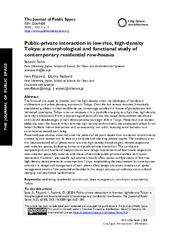Приказ основних података о документу
Public-private interaction in low-rise, high-density Tokyo. A morphological and functional study of contemporary residential row-houses
| dc.creator | Sano, Satoshi | |
| dc.creator | Filipović, Ivan | |
| dc.creator | Radović, Darko | |
| dc.date.accessioned | 2023-10-16T07:34:25Z | |
| dc.date.available | 2023-10-16T07:34:25Z | |
| dc.date.issued | 2020 | |
| dc.identifier.issn | 2206-9658 | |
| dc.identifier.uri | https://raf.arh.bg.ac.rs/handle/123456789/1324 | |
| dc.description.abstract | The focus of this paper is liveable, low-rise high-density urban morphologies of residential architecture and urban planning practices in Tokyo. Over the last several decades, historically established qualities in cities worldwide are increasingly sacrificed in favour of globalization–led ‘universal’ typologies. Tokyo is not an exception: it is gradually changing to a high-rise, high-density built city environment. From a morphological point of view, the paper demonstrates bioclimatic and cultural disadvantages of such developmental paradigm shift in Tokyo. Presented case studies elaborate upon the ways in which low-rise high-density environments and subsequent urban forms better facilitate human interaction and, consequently, can aid in reducing social isolation and contribute to mental well-being. Presented case studies, observed over the period of six years depict how residential environments created by row-houses can be seen as a collection of adjoining private spaces. The emphasis is on the interconnected set of phenomena: low-rise high-density morphologies, climate-responsive semi-exterior spaces, facilitating human and public-private interaction. The conducted morphological and functional analysis shows how design requirements of bioclimatic responsive semi-exterior space fully coincide with those of desirable public-private interface and human interaction. However, site-specific constraints critically affect spatial configurations of low-rise high-density developments in contemporary Tokyo, emphasizing the requirement for case-by-case attention in design and management of such places. Only design processes conscious of spatial management aware of the potential embedded in the design process can enhance socio-cultural interplay and bioclimatic performance. | sr |
| dc.language.iso | en | sr |
| dc.publisher | City Space Architecture | sr |
| dc.rights | openAccess | sr |
| dc.rights.uri | https://creativecommons.org/licenses/by-nc/4.0/ | |
| dc.source | The Journal of Public Space | sr |
| dc.subject | well-being | sr |
| dc.subject | residential architecture | sr |
| dc.subject | place management | sr |
| dc.subject | bioclimatic sustainability | sr |
| dc.subject | Tokyo | sr |
| dc.title | Public-private interaction in low-rise, high-density Tokyo. A morphological and functional study of contemporary residential row-houses | sr |
| dc.type | article | sr |
| dc.rights.license | BY-NC | sr |
| dcterms.abstract | Филиповић, Иван; Сано, Сатосхи; Радовић, Дарко; | |
| dc.citation.volume | 5 | |
| dc.citation.issue | 2 | |
| dc.citation.spage | 63 | |
| dc.citation.epage | 88 | |
| dc.identifier.doi | 10.32891/jps.v5i2.1285 | |
| dc.identifier.fulltext | http://raf.arh.bg.ac.rs/bitstream/id/4592/luisa_bravo,+Journal+Manager,+JPS_5-2_2020_05_SANO_63-88.pdf | |
| dc.type.version | publishedVersion | sr |

